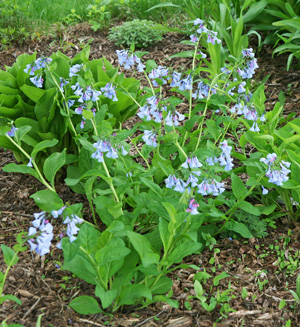
Overview of Virginia Bluebells
Virginia bluebells is a native wildflower found in moist woodlands and river flood plains in eastern North America from New York to Minnesota up into Ontario and Quebec, and from Kansas to Alabama. Mertensia virginica is one of about 40 species in this genus of herbaceous perennials with blue, bell-shaped flowers. Other common names include eastern bluebells, Virginia cowslip, and lungwort oysterleaf.
This plant in the borage family (Boraginaceae) is hardy in zones 3-9. It is considered threatened in its native range, primarily because of habitat destruction and the prevention of natural flooding of rivers and is increasingly found only in isolated locations. This ephemeral perennial plant comes up early in the spring. The emerging foliage is deep purple but quickly turns green. Plants have smooth, oval, blue- to gray-green leaves with prominent veins.
The alternate leaves are petiolate at the bottom of the stem but change to sessile at the top. The leaves may be from 2-8 inches long, with the longer leaves at the base of the plant. The smooth stems are almost succulent but nearly hollow so plants are fragile and will break readily. The occasionally branched stems are mostly green but may be tinged a purple color, especially at the base.
The erect clumps grow up to 2 feet tall and about a foot wide but die back to the ground by early summer as the plant goes dormant shortly after flowering and setting seed. Many novice gardeners mistakenly think their plants have died, only to be surprised the following year when the bluebells emerge in early spring more vigorous than before.
Virginia bluebells bloom in mid-spring (typically from mid-April through mid-May in Wisconsin). Loose clusters of flowers (cymes) are borne at the ends of coiled or arched stems. They do not make a very good cut flower. Purplish pink buds open to sky blue flowers with a delicate, sweet fragrance. There are some variants with pink or white flowers. The pendulous, bell-shaped flowers are composed of five petals fused into a tube, with five white stamens with light brown anthers and a long, slender white central pistil.
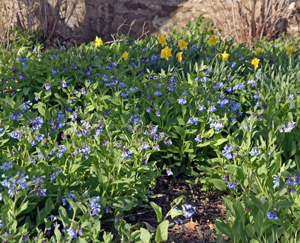
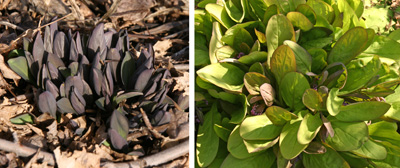
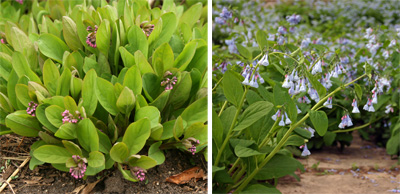
The flowers up to one inch long and are primarily pollinated by bumblebees and other long-tongued bees, and are visited by several types of butterflies, skippers and hummingbird moths, flower flies (syrphids), bee flies and hummingbirds. The bloom period is about 3 weeks. Fertilized flowers produce wrinkled nuts, each with four seeds, in early summer.
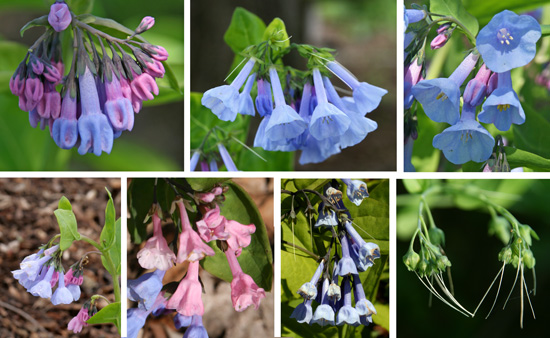
Landscape Use
Mertensia virginica is easily naturalized in moist, shady woodland and works well in wildflower gardens. It combines well with bleeding heart, celandine poppy (Stylophorum diphyllum) and Trillium grandiflorum for an exclusively spring garden. Another attractive combination is with yellow daffodils and pink tulips for a lovely spring show.
Virginia bluebells can be used in borders or other beds but the dying foliage and blank spaces when dormant need to be addressed. If interplanted with other shade-loving perennials, such as hosta, astilbe, bugbane (Cimicifuga racemosa), hosta, Solomon’s seal, twinleaf (Jeffersonia diphylla) or ferns, these other plants will fill in the gaps later in the season.
Empty spaces can also be overplanted with shallow-rooted annuals. When used in mixed beds, the plants’ location should be marked in some way to avoid digging them up or planting directly on top of them when dormant.
This species prefers part to full shade and moist, rich soil. Plant potted plants 10-18″ apart in the fall or after the last frost in spring. Virginia bluebells often form dense colonies and will readily self-seed under ideal conditions.
Propagating Virginia Bluebells
Small seedlings can be transplanted but take several years to bloom. Plants have a long taproot, so once established they should generally not be disturbed. If necessary, established plants can be moved during their dormant period. They do best when moisture is abundant and will decline if the soil is too dry. They have few pests and are not favored by deer.
– Susan Mahr, University of Wisconsin – Madison
Last Update: Bruce Spangenberg, UW-Madison Extension, 2025

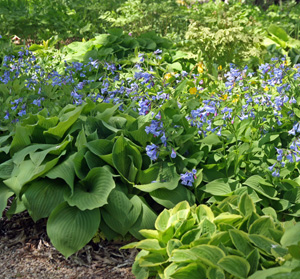
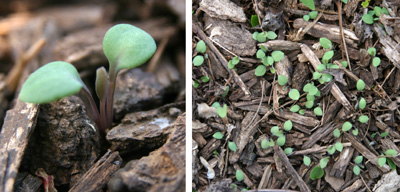





 Aster, Symphyotrichum spp.
Aster, Symphyotrichum spp. Fascinating Fasciation
Fascinating Fasciation Alternatives to Lawn: Groundcovers
Alternatives to Lawn: Groundcovers Marigolds
Marigolds


